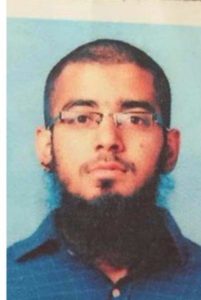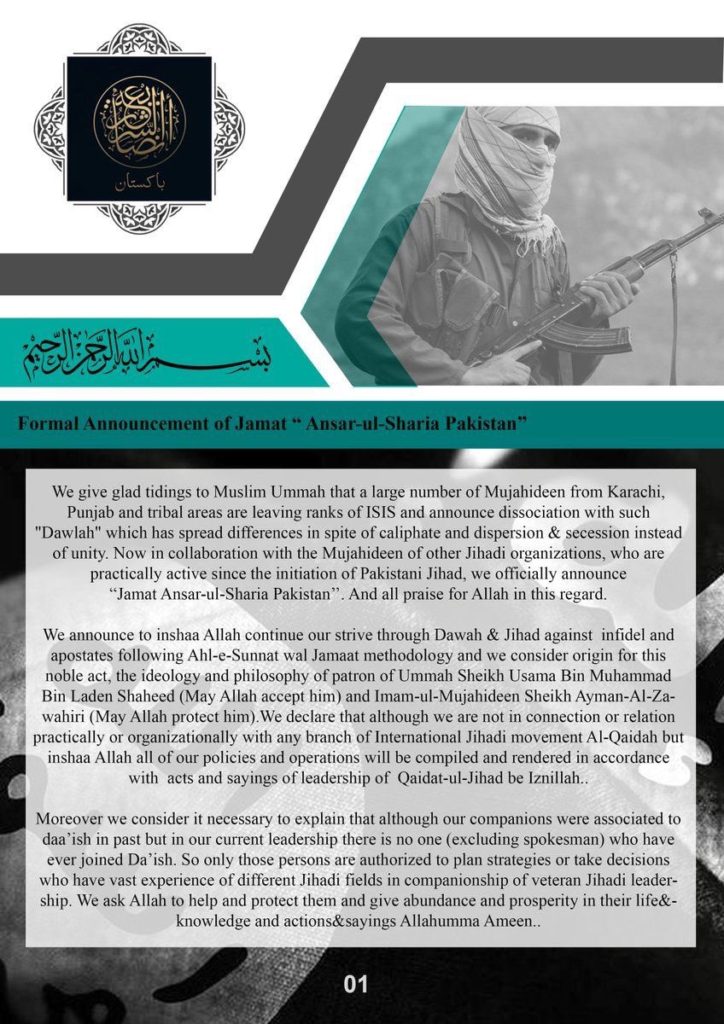The New Face of Jihad
By Ali Arqam | Newsbeat National | Published 8 years ago

Abdullah Hashim
The Ansar-ul-Sharia Pakistan (ASP) is a relatively recent phenomenon among the ranks of jihadi organisations, but one that has garnered much attention after the sensational attack on members of the Ismaili community in Safoora Goth in 2015, which they spearheaded. Founded by Sheheryar, aka Dr Abdullah Hashmi, the ASP counts university graduates and students among its members.
According to reports, the Rangers and Counter-Terrorism Department (CTD) conducted a raid in Baldia Town, Karachi, on October 23, killing Dr Hashmi and seven other suspected militants. In the first week of September, however, it was reported that Abdullah Hashmi and other militants had been arrested by security agents in Kaniz Fatima Society, Karachi. This has led to speculation that the alleged encounter never took place and the men were the subjects of extra- judicial execution.
The ASP members who planned and perpetrated the Safoora Goth massacre and the murder of T2F Director, Sabeen Mehmood, were graduates of elite education institutions. The affiliation of some IT professionals and university students to Al-Qaeda had also been reported earlier, leading to some arrests.
The roots of this affiliation can be traced to the days of the so-called Afghan Jihad, when the Jamaat-e- Islami (JI) was at the forefront of the propaganda and recruitment campaign. Members of its student wing, the Islami Jamiat Talaba (IJT), were actively engaged in the battlefield. The IJT built close ties with organisations like Jundullah and Al-Qaeda. Jundullah was involved in the attack on Corps Commander Karachi, General Ahsan Saleem Hayat, in 2005, and many senior Al-Qaeda leaders were then arrested from the homes of IJT or JI members. A few IJT activists were killed in drone strikes in the Federally Administered Tribal Areas (FATA), along with Al-Qaeda and Haqqani network members.

Sabeen Mahmud’s assassin, Saad Aziz.
Hizbut Tehrir (HuT) is another organisation that has built a network in middle-class localities of Karachi and other major cities. It organises gatherings and events, distributes materials that propagate the idea of a global caliphate and opposes democratic institutions
HuT relies mostly on propaganda activities; it doesn’t resort to violence and focuses on indoctrinating students and college graduates in residential localities. HuT has a network of preachers and fund-raisers. Militant outfits go a step further and recruit people who could actively participate in terrorist activities.
Ansar-ul-Sharia Pakistan is a local variant of militant outfits with similar names from the Middle East. It borrows its name from the cluster of organisations in the Middle East, Ansar Al-Sharia, and local affiliates of Al-Qaeda in the Arabian Peninsula (AQAP) with organisational networks in Yemen, Tunisia, Morocco, Mauritania, Mali, and Egypt.
Sheheryar, alias Abdullah Hashmi, an IT professional and employee of an engineering university announced the formation of the ASP through a letter posted on social networks. The logo used for ASP was different from those used by groups going by similar names in the Middle East. Hashmi expressed disillusionment with Daesh (IS) and rejected their tactics. The letter claimed that people were leaving the IS, to join the ASP. ASP vowed to follow the ideology of former Al-Qaeda chief, Osama Bin Laden, and the present chief, Aiman-Al-Zawahiri, but emphasised that they did not have any organisational links with Al-Qaeda. The latter does not need a direct affiliate in Pakistan, since it has already established a local chapter, Al-Qaeda in the Indian subcontinent (AQIS), with Asim Omer as its chief.
The group later issued an 8-point “Guidelines for the general public.” The document bore the Afghan Taliban flag and another flag with the seal of the prophet (PBUH), similar to the flag used by Al-Qaeda in the Arabian Peninsula (AQAP) and the Islamic State. When policemen were targeted in SITE Karachi during the month of Ramazan, pamphlets found at the site bore Urdu translations of the 8-point guidelines.
Initially, there were speculations that these militants had returned from the battlefields of Syria, being disaffected by IS brutality against the general public, but these claims were baseless. The speculation was based on their rejection of the IS and the history of the Ansar Al-Sharia Yemen, the group linked to it due to a similar name.
It was the September 2 assassination attempt on Khawaja Izhar Ul Hasan, deputy parliamentary leader of the Muttahida Qaumi Movement Pakistan (MQM-P) in the Sindh Assembly, that led to the unearthing of the ASP. Tracing the background of one of the attackers led the police to unveil the Ansar-ul-Sharia network behind the assassination plot. They discovered that this recent entrant to the long list of militant outfits consists of a small group of highly educated militants.
Khawaja Izhar was attacked near his residence when returning from the mosque after Eid prayers. The attack, in which a policeman, a 12-year-old bystander, and one of the attackers were killed, was instantly linked to internal battles within the MQM factions. Farooq Sattar referred to the threatening language used by the MQM-London faction, while the police, in their initial response, linked it to an extortion related dispute between the attacker, Hassan Israr, and MQM workers. But as the investigation progressed, the police started a crackdown on Hassan’s accomplices, and nabbed almost all the members of the group, including the head and spokesman Sheheryar, alias Abdullah Hashmi. The mastermind of the attack, Abdul Karim Sarosh Siddiqui, is still at large.
With increased focus on the new outfit, and the law enforcement agencies’ (LEA) bid to link it to various terrorist episodes, other banned outfits have found space to reactivate their sleeper cells. In July this year, it was reported that the Tehrik-e-Taliban Pakistan (TTP) resumed their effort to generate financial resources in the city. Sleeper cells had been activated in areas where they were active in the past.
Abu Bakkar Yousafzai is associated with a non-governmental organisation working to prevent charity funds and financial resources from falling into the hands of militant and sectarian organisations. Working within communities in Pashtun neighbourhoods, he observed people being approached by individuals asking them to donate funds to these outfits.
Before the unveiling of the ASP leadership as masterminds of the Safoora Goth attacks, police officials were not taking their threats seriously despite having knowledge of their objectives. They continued to react to the killings of the policemen with staged encounters of militants in captivity.

In August, for instance, the CTD killed two detained militants near Abul Hasan Ispahani road in a staged encounter, claiming they were involved in the killings of policemen. In another incident, bullet-riddled bodies of three militants were found in Gadap Town near a checkpost that had been attacked a week earlier, resulting in the killing of two members of the police volunteer force. The attack was claimed by the ASP.
The trend of highly educated militants taking up positions against the internal security apparatus is a dangerous one. Organisations like the ASP thrive in an environment of impunity and some security analysts say they aim to build an environment of distrust around the role of LEAs. In a typical propaganda tactic, they accuse the intelligence agency of disguising themselves as jihadis to attack members of the public and cause disrepute to jihad. They vowed they would not attack public gatherings, schools, mosques etc. to avoid common people getting killed and only target the police, law enforcement agencies and military/intelligence targets. It is a divisive tactic, on the one hand, a response to criticism of terrorist acts which kill mostly civilians, and on the other, a desperate attempt by the jihadis to win public support.
Policemen are vulnerable to terrorist attacks as they are more visible in public spaces, and live in marked residential localities that can be easily identified. In addition, they do not have the capacity to deal with unconventional threats.
Asim Bashir Khan, an economist and social scientist, sums it up quite well. “In an era of terrorism and complex security vulnerabilities, the role of the police is as important as that of the national defence forces. The recent operations Zarb-e-Azb and Raddul Fasad, contributed significantly towards peace and internal security, especially in Karachi. In the context of the National Action Plan (NAP) and these LEA operations, the context of policing has gained more importance, for sustainable peace; a critical role which the police is endowed and trusted with.”
He concludes, “Allocation of more resources, procurement of modern weaponry, trainings and welfare funds would certainly add more incentive for policing.”
The whole narrative of internal security relies on the so-called foreign hands and conspiracy theories spread through the mainstream media and internet. These conspiracy theories put out by the spin doctors on the TV screens, and that imagined world of adversaries, ignores the very basic incapacities of our educational system and creates a conducive environment for militant organisations to approach prospective recruits.
Amidst the ongoing civil-military standoff on different issues, the director general Inter-Services Public Relations (ISPR), Major General Asif Ghafoor, visited Karachi University and spoke to the students on various issues. An earlier event held at the general headquarters of the armed forces (GHQ) was a bid to examine the increased radicalisation of university students, and to discuss the role of youth in rejecting extremism.
Organised by the ISPR, in collaboration with the Higher Education Commission (HEC), the event had university vice chancellors among the participants. Speakers included the army chief and members of the academia. The speeches were posted on the ISPR website, but a student from Islamia College Peshawar, Hareem Zafar, had some observations while representing students’ perspectives. She reminded the policy makers, academics and vice chancellors that higher educational institutions are no more a place for getting answers to critical questions, grooming minds or provoking thought, nor do these institutions provide an environment to help students to divert their energies to creative activities, to promote the culture of debate and reason.
Addressing the participants, Hareem Zafar said, “We have gathered here because we have doubts. Doubts about how our universities have started producing mobs instead of scholars, about how doctors are becoming bombers, and businessmen are turning to extremism. We have doubts about whether it is all dark and dim, or is there light at the end of the tunnel? Are we failing somewhere in our universities?” It seems that we are.
Ali Arqam main domain is Karachi: Its politics, security and law and order


